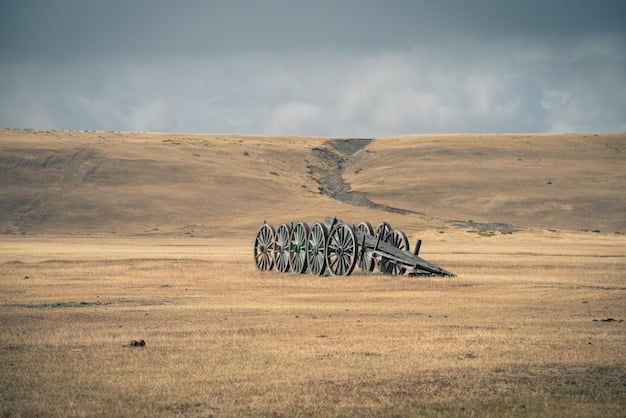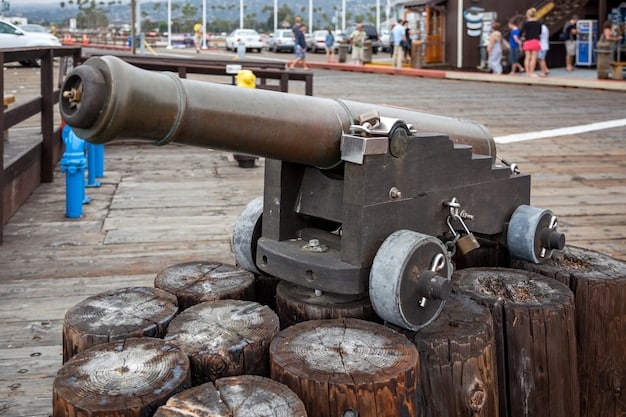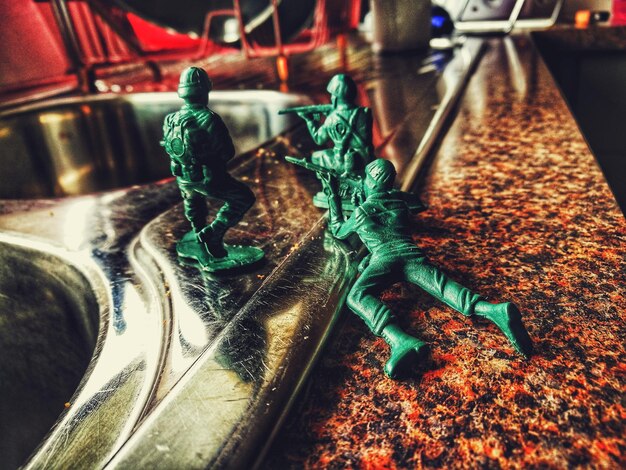The American Civil War: A Comparative Analysis of Artillery

The American Civil War witnessed a significant reliance on artillery, with both the Union and Confederate armies employing diverse weapon systems and tactics that shaped battlefield outcomes and military strategies.
The American Civil War, a defining moment in U.S. history, was characterized by intense battles where artillery played a crucial role; this article provides the American Civil War: A Comparative Analysis of Union and Confederate Artillery by examining each side’s strengths, weaknesses, technologies, and impacts.
Union and Confederate Artillery: An Overview
The American Civil War (1861-1865) saw extensive use of artillery by both the Union and Confederate armies. Artillery played a vital role in sieges, battles, and overall military strategy. Understanding the artillery used by each side offers insights into the technological and tactical approaches of the war.
This section examines the broad characteristics of Union and Confederate artillery, setting the stage for a detailed comparison.
Union Artillery: Strengths and Characteristics
Union artillery was characterized by its superior industrial capacity and logistical support, which enabled the North to produce and deploy more advanced and reliable artillery pieces.
Confederate Artillery: Strengths and Characteristics
Confederate artillery, while frequently outgunned and undersupplied, demonstrated remarkable ingenuity and adaptability. Using captured Union weapons and locally produced artillery, the Confederacy developed innovative tactics to maximize their limited resources.
- Industrial Capacity: The Union’s robust industrial base allowed for mass production of artillery and ammunition.
- Weapon Standardization: The Union army often used standardized artillery pieces, streamlining maintenance and supply.
- Naval Artillery: The Union Navy’s powerful naval guns significantly impacted coastal and riverine operations.

In summary, Union artillery excelled in quantity and technology, while Confederate artillery demonstrated remarkable adaptability and tactical innovation despite facing significant resource limitations.
Artillery Technology and Innovation
The American Civil War spurred significant advancements in artillery technology. Both the Union and Confederate armies adopted rifled cannons, which offered increased accuracy and range compared to smoothbore artillery.
This section examines the key technological innovations in artillery and their impact on the war.
Rifled Cannons: Precision and Range
Rifled cannons represented a major advancement, using spiral grooves to impart spin to the projectile, stabilizing it and increasing its range and accuracy.
Smoothbore Artillery: Still Relevant
Despite the rise of rifled cannons, smoothbore artillery still played a significant role, particularly in close-range engagements where their ease of use and faster firing rates were advantageous.
- Parrott Rifles: Union Parrott rifles were known for range and accuracy, though prone to bursting.
- 12-pounder Napoleon: A versatile smoothbore cannon used by both sides for its reliability and effectiveness.
- Ammunition Types: Development of explosive shells, including the introduction of percussion fuses and improved shrapnel.
In effect, the technological advancements in artillery during the Civil War shifted battlefield tactics and altered the nature of combat, rewarding armies that could effectively deploy and maintain these new weapons.
Tactical Employment of Artillery
Artillery’s role extended beyond its technological capabilities to its tactical employment on the battlefield. Both sides utilized artillery to soften enemy lines, suppress infantry assaults, and support offensive operations.
This section examines the different tactical approaches used by the Union and Confederate armies.
Union Tactics: Massed Fire and Barrages
The Union army often employed massed artillery fire to overwhelm Confederate positions. Concentrated barrages aimed to demoralize enemy troops and create breaches in defensive lines.
Confederate Tactics: Defensive Positions and Enfilade Fire
Confederate artillery was frequently positioned to maximize defensive advantages. Enfilade fire, which targeted enemy lines from the side, was a common tactic to inflict heavy casualties.
Some effective strategies included:
- Counter-Battery Fire: Both sides attempted to suppress enemy artillery through counter-battery fire.
- Artillery in Sieges: Artillery played a crucial role in siege operations, such as at Vicksburg and Petersburg.
- Coordination with Infantry: Successful attacks often involved close coordination between artillery and infantry units.

Ultimately, the tactical employment of artillery during the Civil War underscored its significance as a decisive factor in shaping the outcomes of battles and campaigns, providing a considerable advantage to those who could properly coordinate artillery with their infantry and cavalry.
Logistical Challenges and Support
Logistical support was essential for maintaining effective artillery operations. Supplying artillery units with ammunition, replacement parts, and trained personnel presented significant challenges for both the Union and Confederate armies.
This section examines the logistical difficulties faced by each side and their impact on artillery effectiveness.
Union Logistics: Superior Infrastructure
The Union army benefited from a well-developed industrial base and transportation network. Access to railroads, factories, and supply depots enabled the North to efficiently সরবরাহ artillery units.
Confederate Logistics: Resource Scarcity
The Confederate army faced severe logistical constraints due to limited industrial capacity and disrupted supply lines. The South struggled to produce and distribute artillery pieces, ammunition, and spare parts and often relied on captured Union supplies.
Key considerations were:
- Ammunition Supply: Adequate ammunition supply was critical for sustained artillery fire.
- Repair and Maintenance: Regular maintenance and repair of artillery pieces were essential for operational readiness.
- Trained Personnel: Skilled artillery crews were needed to operate and maintain the cannons effectively.
Therefore, logistical support played a crucial role in determining the effectiveness of artillery operations during the Civil War, with the Union’s superior infrastructure providing a major advantage.
Impact on Key Battles
Artillery significantly influenced the outcomes of numerous key battles throughout the American Civil War. Its ability to inflict heavy casualties, suppress enemy fire, and disrupt troop movements made it an invaluable asset.
This section highlights the impact of artillery on several pivotal battles.
Gettysburg: Artillery Duel
At Gettysburg, artillery played a crucial role in shaping the battle. The Union army effectively positioned its artillery to defend Cemetery Ridge and Little Round Top, while Confederate artillery attempted to soften Union lines before Pickett’s Charge.
Vicksburg: Siege Warfare
The siege of Vicksburg demonstrated the effectiveness of artillery in siege warfare. Union artillery bombarded Confederate defenses, paving the way for Union forces to capture the city and gain control of the Mississippi River.
Specific examples include:
- Antietam: Artillery inflicted heavy casualties on both sides during the battle.
- Chickamauga: Confederate artillery played a key role in repelling Union attacks.
- Petersburg: The long siege of Petersburg involved extensive use of artillery by both armies.
As a result, in these battles, artillery had a direct and meaningful impact on the casualties inflicted and the ultimate outcome of the battle.
Long-Term Effects and Lessons Learned
The American Civil War brought about lessons learned in artillery usage. The experiences gained during the war influenced subsequent military doctrine, artillery design, and battlefield tactics.
This section discusses the long-term effects of Civil War artillery practices.
Advancements in Military Doctrine
The Civil War highlighted the importance of artillery coordination with infantry and cavalry. Military doctrine evolved to emphasize combined arms tactics and the integration of artillery into overall battle plans.
Influence on Artillery Design
The advancements in rifled cannons and ammunition designs during the Civil War had a lasting impact on artillery development. Subsequent artillery pieces incorporated rifling, improved breech-loading mechanisms, and more effective projectiles.
The main points are:
- Standardization: The need for standardized artillery pieces and ammunition became apparent.
- Logistical Planning: The importance of logistical planning and supply chain management was underscored.
- Training and Expertise: Skilled artillery crews were essential for effective artillery operations.
So, the long-term effects and lessons learned from the Civil War significantly shaped military practices and continued to influence artillery technology and tactics for decades to come.
| Key Point | Brief Description |
|---|---|
| ⚙️ Union Artillery | Superior industrial capacity and logistics. |
| 🛡️ Confederate Artillery | Resourceful, adapted tactics due to limited supplies. |
| 🎯 Rifled Cannons | Increased accuracy and range impacted tactics. |
| ⚔️ Tactical Use | Artillery softened lines and defended positions. |
Frequently Asked Questions
▼
Union artillery benefited from superior industrial capacity and logistical support, allowing for better production and deployment. Confederate artillery was often resource-limited but showed great adaptability.
▼
Rifled cannons increased the range and accuracy of artillery fire, influencing battlefield tactics and leading to changes in strategic deployments.
▼
The Confederate army struggled with limited industrial capacity and disrupted supply lines, which made it difficult to produce and distribute artillery pieces and ammunition effectively.
▼
Artillery played significant roles in battles such as Gettysburg, Vicksburg, and Antietam, where it influenced the outcome with effective deployments and barrages.
▼
The Civil War influenced military doctrine and artillery design, emphasizing combined arms tactics, rifled cannons, standardized ammunition, and logistical planning for effective artillery operations.
Conclusion
In summary, the American Civil War: A Comparative Analysis of Union and Confederate Artillery reveals that artillery proved to be a critical component of military strategy for both sides, shaping key battle outcomes and significantly influencing the long-term development of military tactics and technology.





